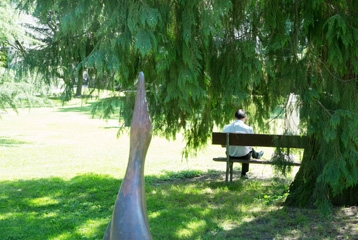Discover some of the numerous curiosities that make the Plainpalais Jonction district so charming.
The Cimetière des rois: a stroll through the local pantheon
A favourite place for the people of Geneva to take a stroll, the cimetière des Rois is something of a local pantheon. It houses the tombs of figures who played an important role in the life of the city, along with a number of famous foreigners who died in Geneva. Those tombs include:
- Jean Calvin, reformer;
- Rodolphe Töpffer, inventor of the comic strip;
- Jorge Luis Borges, Argentine writer;
- Emile Jacques-Dalcroze, famous musician and pedagogue;
- Key political figures in the history of Geneva, such as Léon Nicole, James Fazy, Adrien Lachenal…
Thirty metres from Calvin’s tomb is that of Grisélidis Réal, Geneva’s most famous prostitute and author of La Passe imaginaire. The arrival of her remains in the Cimetière des Rois in 2009 caused a great deal of controversy.
The Plainpalais flea market
Since 1970, the Plaine de Plainpalais has played host to one of the largest flea markets in Switzerland. An absolute must for the region’s second-hand goods dealers, its stands carry all sorts of products ranging from bric-à-brac to books, clothes, jewellery and much more. Curious passers-by and bargain hunters have the chance to unearth surprising objects every Wednesday and Saturday.
The Museum of Old Plainpalais
Created in 1953 under the impetus of the Association des intérêts de Plainpalais, this minute museum on a human scale contains precious documents and photographs which preserve memories of the long history of the Plainpalais sector.
It is housed in a Beaux Arts-style building dating back to the end of the 19th century which formerly served as the Plainpalais town hall, when the municipality was independent, then the headquarters of the social services department of the City of Geneva from 1930 to 1953.
Factories transformed into cultural centres
Throughout its history, la Jonction has been home to industrial buildings, some of which have been converted into cultural centres:
The buildings of the former Société genevoise d’instruments de physique (SIP), founded in 1869, which has housed the contemporary art building (BAC) since 1994, consisting of the Museum of Modern and Contemporary Art (MAMCO)(MAMCO) and the Centre for Contemporary Art, as well as a small theatre, dance studios and artists’ workshops.
The Usine genevoise de dégrossissage d’or, founded in 1880, has now become the heart of the Geneva “underground” culture. An alternative cultural centre, l’Usine boasts a range of musical, artistic and cultural activities.
Built in 1886, the Bâtiment des Forces motrices (BFM) is a listed building bearing stunning witness to the industrial architecture of Geneva at the end of the 19th century. Used in the past to take advantage of the force of the Rhône, to control the level of the lake and to provide running water to the people of Geneva, the BFM was purchased by the City and converted into a theatre hall in 1995. Did you know that the Jet d’eau was born here?
The Coulouvrenière gas plant was in service from 1844 to 1915. Having housed first the Road Services offices then the Services Industriels de Genève (SIG), the site was partially abandoned. Having become an “urban wasteland”, the buildings and the surrounding land were taken over in the mid-1990s by some 300 craftsmen and artists who joined forces to form the Artamis collective. When it was realised that the site was highly polluted by substances threatening the groundwater, they were forced to leave the site. The now sanitised site will soon become home to the Eco-district of la Jonction.
Some works, monuments and tourist sites in Plainpalais Jonction
Article modifié le 25.04.2022 à 14:13

